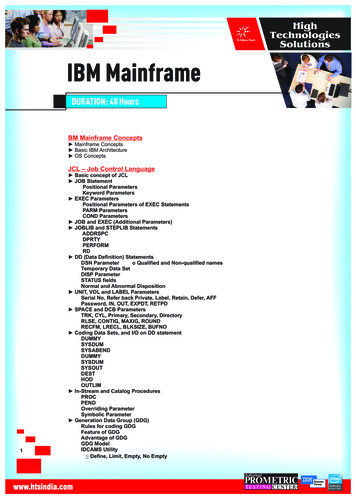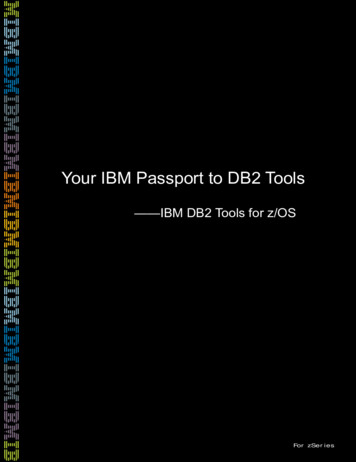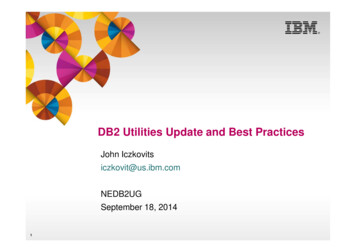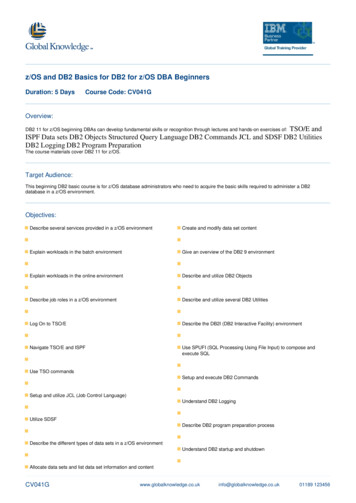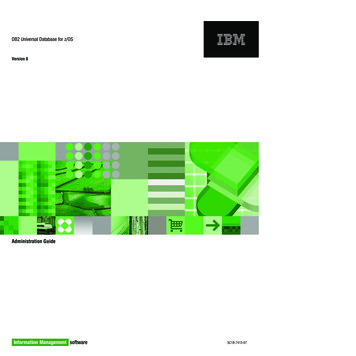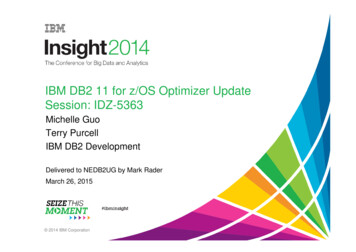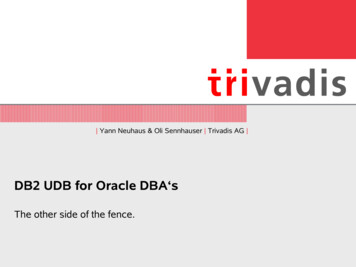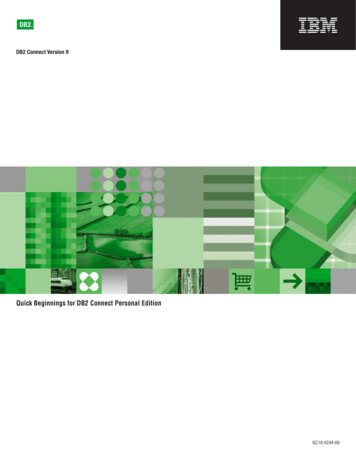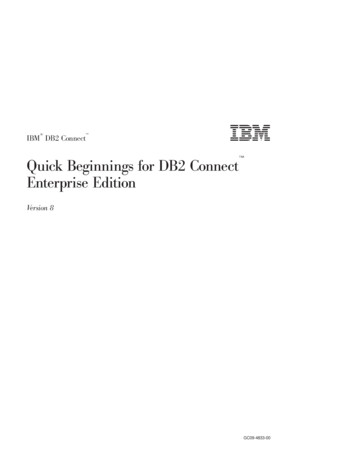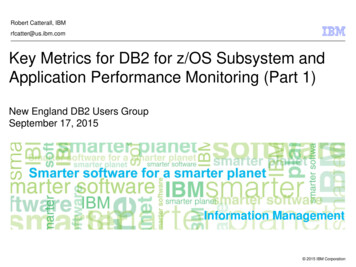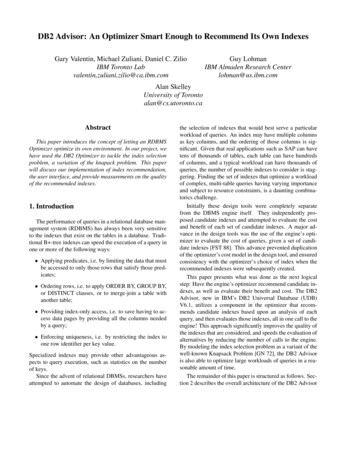
Transcription
DB2 Advisor: An Optimizer Smart Enough to Recommend Its Own IndexesGary Valentin, Michael Zuliani, Daniel C. ZilioIBM Toronto Labvalentin,zuliani,zilio@ca.ibm.comGuy LohmanIBM Almaden Research Centerlohman@us.ibm.comAlan SkelleyUniversity of Torontoalan@cs.utoronto.caAbstractThis paper introduces the concept of letting an RDBMSOptimizer optimize its own environment. In our project, wehave used the DB2 Optimizer to tackle the index selectionproblem, a variation of the knapack problem. This paperwill discuss our implementation of index recommendation,the user interface, and provide measurements on the qualityof the recommended indexes.1. IntroductionThe performance of queries in a relational database management system (RDBMS) has always been very sensitiveto the indexes that exist on the tables in a database. Traditional B -tree indexes can speed the execution of a query inone or more of the following ways:Applying predicates, i.e. by limiting the data that mustbe accessed to only those rows that satisfy those predicates;Ordering rows, i.e. to apply ORDER BY, GROUP BY,or DISTINCT clauses, or to merge-join a table withanother table;Providing index-only access, i.e. to save having to access data pages by providing all the columns neededby a query;Enforcing uniqueness, i.e. by restricting the index toone row identifier per key value.Specialized indexes may provide other advantageous aspects to query execution, such as statistics on the numberof keys.Since the advent of relational DBMSs, researchers haveattempted to automate the design of databases, includingthe selection of indexes that would best serve a particularworkload of queries. An index may have multiple columnsas key columns, and the ordering of those columns is significant. Given that real applications such as SAP can havetens of thousands of tables, each table can have hundredsof columns, and a typical workload can have thousands ofqueries, the number of possible indexes to consider is staggering. Finding the set of indexes that optimize a workloadof complex, multi-table queries having varying importanceand subject to resource constraints, is a daunting combinatorics challenge.Initially these design tools were completely separatefrom the DBMS engine itself. They independently proposed candidate indexes and attempted to evaluate the costand benefit of each set of candidate indexes. A major advance in the design tools was the use of the engine’s optimizer to evaluate the cost of queries, given a set of candidate indexes [FST 88]. This advance prevented duplicationof the optimizer’s cost model in the design tool, and ensuredconsistency with the optimizer’s choice of index when therecommended indexes were subsequently created.This paper presents what was done as the next logicalstep: Have the engine’s optimizer recommend candidate indexes, as well as evaluate their benefit and cost. The DB2Advisor, new in IBM’s DB2 Universal Database (UDB)V6.1, utilizes a component in the optimizer that recommends candidate indexes based upon an analysis of eachquery, and then evaluates those indexes, all in one call to theengine! This approach significantly improves the quality ofthe indexes that are considered, and speeds the evaluation ofalternatives by reducing the number of calls to the engine.By modeling the index selection problem as a variant of thewell-known Knapsack Problem [GN 72], the DB2 Advisoris also able to optimize large workloads of queries in a reasonable amount of time.The remainder of this paper is structured as follows. Section 2 describes the overall architecture of the DB2 Advisor
and its user interface. Section 3 details how the optimizerthrough the recommendation algorithm is able to recommend the best indexes for a given query. Section 4 presentsthe algorithm to extend this concept beyond just a singlestatement at a time to a workload of SQL statements, andsubject to resource constraints (such as disk space). Section 5 contrasts DB2 Advisor with previous work on indexrecommendation. In Section 6, we give some preliminaryperformance measurements, both of the time for the algorithm to run and of the resulting execution time for workloads benefitting from the Advisor’s advice. Section 7 discusses future work.USERSystem MemorySystem DiskIndex SmartGuide GraphicalUser InterfaceDatabase "Sample"db2advis command-linetoolPackagesAdvise TablesDataDB2 Universal Database2. ArchitectureAt the highest level, the DB2 Advisor works as a blackbox index-recommendation engine. The black-box has twoinputs: a set of SQL statements known as the workload, andstatistics describing the target database. There is only oneoutput: the recommended indexes.Architecturally, the DB2 Advisor consists of:Index SmartGuide A graphical user interfacedb2advis A command-line driven utility for recommending indexesOptimizer Extensions have been written into the DB2 Optimizer for the recommendation of indexes as well astheir evaluationAdvise tables These new tables are created for the purposeof advising, and they are used as a communication vehicle between db2advis and the OptimizerThe preferred method of invoking the Index Advisoris through the Graphical User Interface called the IndexSmartGuide. We have included here two screen snapshotsof the Index SmartGuide. The screen snapshot in Figure 2shows how the user can specify a workload of statements.The SmartGuide automatically searches for SQL statementsand their frequency of execution in the SQL cache and imports them. Effectively, the DB2 dynamic SQL cache storesrecently-executed SQL statements. The Index SmartGuidealso imports SQL statements from statically-compiled SQLstatements, which are known as packages in DB2 terminology. Other sources of SQL statements include the QueryPatroller load scheduling product, and recently explainedSQL statements. Lastly, statements can be entered manually or using cut-and-paste. The workload is stored in auser-owned table, called ADVISE WORKLOAD.In other windows of the SmartGuide (see the tabs at thetop), the user may optionally specify constraints on the estimated disk to be consumed by all indexes recommended,SQL CacheDB2 OptimizerDatabase StatisticsFigure 1. Architecture of DB2 Advisoror on the maximum time for DB2 Advisor to spend improving its recommendations. For example, the user can requireDB2 Advisor to work for no more than 5 minutes, and torecommend that all indexes consume no more than 5 Gigabytes.The SmartGuide then calls the db2advis utility, an application program that contains the major optimizationlogic of DB2 Advisor. For each statement in the ADVISE WORKLOAD table, it invokes the DB2 UDB Optimizer in one of two new EXPLAIN modes that either RECOMMEND INDEXES or EVALUATE INDEXES. TheOptimizer stores the indexes it recommends in another userowned table, called ADVISE INDEX. The screen snapshotin Figure 3 shows the index recommended by db2advis forthe workload of Figure 2. By clicking on the ”Show workload details” button, the user can see how much the recommended indexes will benefit each statement in the workload.Alternatively, the user may invoke the db2advis utilitydirectly from the command line, providing options forspecifying the database, the workload of SQL statements,the constraints, and various other options. Example1 shows the invocation of db2advis for a single SQLstatement in the ”sample” database. In less than twoseconds, DB2 Advisor determines the best indexes tocreate and the estimated improvement in the executiontime if they were created, as well as the DDL to create them.EXAMPLE 1: db2advis -d sample -s "select * fromt1,t2 where t1.c1 t2.c2"execution started at timestamp 1999-0706-19.02.32.617867Calculating initial cost (without recomm-
Figure 2. Specifying a workload of statementsmended indexes) [82.237053] timeronsInitial set of proposed indexes is ready.Found maximum set of [2] recommended indexesCost of workload with all indexes included[25.879040] timeronstotal disk space needed for initial set [2]MBtotal disk space constrained to [-1] MB-- -Index Advisor tool is finished.2 indexes in current solution3. Single query optimizationThe algorithm for the index-recommendation engine indb2advis is covered in the next two sections. The first section will discuss the simple case of recommending indexesfor a single SQL statement. The subsequent section extendsthe algorithm to accommodate for a workload of queries.[ 82.2371] timerons (without indexes)[ 25.8790] timerons (with current solution)[%68.53] improvementTrying variations of the solution set.--- execution finished at timestamp 1999-0706-19.02.34.154307---- LIST OF RECOMMENDED INDEXES-- -- index[1], 1MBCREATE INDEX WIZ0 ON "VALENTIN"."T2" ("C2"ASC) ;-- index[2], 1MBCREATE INDEX WIZ2 ON "VALENTIN"."T1" ("C1"ASC) ;The algorithm for recommending indexes is an extension of the existing process for optimizing an SQL query inthe DB2 Compiler. The old process is augmented with theinjection of a multitude of ”virtual indexes” - hundreds ofindexes whose metadata has been temporarily introducedinto the schema only for the duration of the optimizationprocess.To illustrate the approach, suppose that all possible indexes were temporarily injected into the schema model.The DB2 Compiler would then be faced with its usual optimization process, except that there would be a lot moreindexes in the schema to consider. When the optimizationprocess has completed, the DB2 Compiler produces the optimal Query Access Plan. If this plan contains one or morevirtual indexes, then these indexes are the recommended indexes. Effectively, we let the optimizer choose which indexes it likes.
Figure 3. View the recommended indexesIn practice, there are problems with this approach. Themost immediate issue is that the enumeration of all possibleindexes produces a working set which is too big. In DB2,a table with n columns can support a very large number ofindexes, as shown by Formula 1.Formula 1 (Number of Possible Indexes) Given a tablewith columns, how many different indexes can exist containing columns, where? There are choices forthe first column in the index. For the second column, thereremaining choices. As more columns are added,arethe total number becomesor. Therefore the total number of indexes thatcan be created on a table with columns is " ! # &% However, in DB2 UDB, each column of an index mayindividually be defined as either ascending or descending.Therefore, for a given , the space of possible indexes ismultiplied by . As a result, we adjust our first formula tobecome: # " ! ' # ( # &% Therefore, in practice, there has to be a limit on the number of virtual indexes enumerated. The DB2 Advisor limitsthe number of virtual indexes by using the DB2 Optimizeritself to suggest indexes intelligently, based upon its knowledge of how it wants to evaluate a given query. We callthis approach the ”Smart column Enumeration for IndexScans” (SAEFIS) enumeration algorithm. This algorithmanalyzes the statement predicates and clauses to producesets of columns that might be exploited in a virtual index.There are 5 such sets:EQ columns that appear in EQUAL predicatesO columns that appear in the INTERESTING ORDERSlist. This includes columns from ORDER BY andGROUP BY clauses, or join predicates.RANGE columns that appear in range predicatesSARG columns that appear in any predicates but nestedsubqueries or those involving a large object (LOB).REF Remaining columns referenced in the SQL statement.Then various combinations of (subsets of) these sets areformed, in order, eliminating any duplicate columns:1. EQ O2. EQ O RANGE3. EQ O RANGE SARG4. EQ O RANGE REF
5. O EQ6. O EQ RANGE7. O EQ RANGE SARG8. O EQ RANGE REFAs a safety net to make sure the simplest indexes arenot missed, and to evaluate how well the SAEFIS approachworks, we have also implemented an algorithm to enumerate all possible indexes, stopping after a certain maximumnumber of indexes is reached. We call this the ”Brute Forceand Ignorance” (BFI) enumeration algorithm. There areseveral ways to implement this enumeration. We have takena simple recursive algorithm and extended it to accommodate for ascending/descending columns.Here is a pseudo-code version of the final recommendation algorithm:ALGORITHM 1:RECOMMEND INDEXES(Statement S)1. Enable ”RECOMMEND INDEXES” mode2. Enter the DB2 Optimizer3. Inject the schema with virtual indexes using SAEFISand generate their statistics4. Inject the schema with virtual indexes using BFI andgenerate their statistics5. Construct the best plan for S by calling the DB2 Optimizerby enumerating plans, join orderings, and access methods.Only a small amount of code was written in order to enumerate virtual indexes and inject them into the schema.Note that Algorithm 1 could be used as a subroutinewithin any existing Index Recommendation algorithm, notjust our algorithm, which is detailed in Section 4 below. Forexample, it could be plugged in as a method for enumeratingindexes in Daniel Zilio’s Branch-and-Bound based method[Zilio 98] or in Whang’s Drop-based method [Whang 85].3.1. Index StatisticsOnce the index columns are defined, the optimizer stillrequires statistical information about each virtual index.Without proper statistics, the optimizer will be unable toevaluate the cost of scanning an index, fetching selectedrows from an index, or updating an index.The statistics for virtual indexes are generated based onthe corresponding table and column statistics, deducing information on index cardinalities, B -Tree levels, and thenumber of leaf pages and non-leaf pages. Some propertiescannot be deduced easily, such as clustering and uniqueness. For these properties, we assign pessimistic values.For example, we assume that there will be no clustering onthe table per the index order. This behaviour allows the optimizer to be cautious as it uses virtual indexes, and avoidcosting these indexes at performance levels which cannotbe guaranteed.The statistics for each virtual indexes are derived as follows:6. Scan the optimal plan, searching for virtual indexesIndex Key Width, KW: the sum of the average width ofeach column in the index definition.7. Submit these indexes back to the user as ”recommended”.Index Clustering: none (worst-case value).The essence of this algorithm is that the DB2 Optimizerboth suggests candidate indexes and makes the decision onwhich indexes perform best. Importantly, both steps happenin a single call to the DB2 UDB engine. This approach hasmany advantages. The first advantage is that the efficiencyof the recommendation process is maximized by enteringthe DB2 Optimizer (and hence the DB2 Engine) just onceper single query. The second advantage is that no secondaryor external optimizer is needed, either to suggest candidateindexes or to evaluate their cost. This reduces the maintenance of code that is redundant of the Optimizer’s costequations. Instead, by having the Optimizer itself simplyinject likely-looking virtual indexes, and estimating theirstatistics, we have easily extended the DB2 Optimizer froman SQL Optimizer into an index selection optimizer. Thelast advantage is that the DB2 Optimizer does not need tobe significantly modified. Once the virtual indexes are injected, the Optimizer continues working as it always hasIndex Density: none (worst-case value).Percent Free: DB2 default, 15%. ) *-,/. 0/1 3254 76 ,/.80/columns,1 9 : ;# &% FKCARD:, / ,/.80/1 ;@?Cardinality of an index withwhereCARD: cardinality of the table; 4COLCARD : cardinality (i.e. number of distinct values) of the th column of the indexNumber of Leaf Pages, NL: calculated from the indexcardinality, page size, overheads for each key andpage, assuming each page is fully packed with keys,using the following formula:* A A DC&P8EGF QSHJRNI P KLCNM M O OBTU WV&XLYZY P P I\CN[ C ]& a
where:KPP: keys per pagePSIZE: page size (can be 4096 or 8192 bytes in DB2UDB)POH: page header overhead in a leaf pageKOH: key overhead.Total Number of Non-Leaf Pages, TNL: calculated fromnumber of leaf pages, key size, and page overhead asa recursive function. The recursion starts at the leaflevel, and computes the number of pages at each level,continuing until the number of pages has reached one(representing the root node):cb A TU dC&P8EGF QSHJI R eKLe Y I Y CNM&M O OTU gfihkj )ml/ n o*-bcpc,/.80/1TU gf ! j e I&YrCNqtsve uxY w yTU ob{z bc n }8TB " ! TB gf ; j; &%where:EPNL number of entries per non-leaf pageNLPOH page header overhead in a non-leaf pageNLEOH overhead of an entry in a non-leaf pageNLf;jnumber of non-leaf pages in level4NLEVELS number of levels in the index4. Workload OptimizationIn this section, we will present the extensions to the algorithm that permit the DB2 Advisor to recommend indexesfor a workload of statements.Ideally, we would optimize the recommendation of indexes for a workload of statements in a single invocation ofthe DB2 Optimizer. There is a method of using an optimizerto work on several statements in one invocation, which iscalled Mass Query Optimization (MQO). Today, however,no commercial Relational Database product supports MassQuery Optimization, and therefore this was not an optionfor the DB2 Advisor.As seen before in Figure 1, the DB2 Advisor has as acomponent a utility called db2advis. In this utility, we haveadded an index-selection algorithm which uses the resultsof the single-query recommendations as a starting point andsearches for the optimal combination of indexes for a fullworkload.The workload optimization algorithm contained indb2advis models the index selection problem as an application of the classic Knapsack Problem, a special type of0-1 integer programming [GN 72]. Each index is an itemthat may or may not be put into the knapsack, as indicatedby a variable for that index that can be 0 or 1 (a part of anindex is useless). Each index also has an associated benefitand size. The benefit for an index is defined as the improvement in estimated execution time that an index contributesto all queries that exploit it, times the frequency that eachquery occurs in the workload. The size is just the estimatedsize of the entire index, in bytes. The knapsack has a fixedmaximum size for all items in the solution. The objectiveis to maximize the benefit of all items in the knapsack. Ifthe integrality constraint is relaxed, it is well known that theoptimal solution accepts the entities into the knapsack in order of decreasing ratio of benefit to size, until the knapsackis full.There are, however, a few complications in our straightforward application of the Knapsack Problem. First of all,we have relaxed integrality, but in reality it makes no senseto have a fraction of an index. Secondly, negative benefit accrues for updating each index in UPDATE, INSERT,and DELETE statements to that index’s table. But at thetime we compute the benefit for such statements, we don’tyet know all the indexes that might be created by RECOMMEND INDEX. Thirdly, we have attributed all the benefitresulting from a set of indexes to every index in a query. Inreality, the benefit of each index is a function of what otherindexes exist (i.e. the benefit of index A can differ when index B is present or absent), and attributing all the benefit toevery index of the query is double-counting. This relates tothe concept of ”separability”, discussed in the next section.To adjust for all of these complications, we refine the initialsolution found by the Knapsack order in a routine calledTRY VARIATION, which creates a variant of the solutionby randomly swapping a small set of indexes in the solutionfor a small set of indexes not in the solution. The workload is then re-EXPLAINed with this variant set of virtualindexes in the EVALUATE INDEXES EXPLAIN mode. Ifthe variant solution is cheaper overall, it becomes the current solution. TRY VARIATION continues until the user’stime budget has been exhausted.Algorithm 2 describes the algorithm of db2advis for aworkload W of SQL statements:ALGORITHM 2:1. GetWorkload W, including the frequency of executionof each statement.2. R 3. For each Statement S in W,
(a) EXPLAIN S with existing indexes, returningS.cost with existing indexes.4. For each Statement S in W,(a) EXPLAIN S in RECOMMEND INDEX mode,i.e. with virtual indexes(b) R R RECOMMEND INDEXES(S)5. For each index I in R(a) I.benefit S.cost with existing indexesS.cost with virtual indexesAnother weakness in these early algorithms was the assumption of separability. [Whang 85] made the case that index selection for each relation can be made independentlyof other relations. This assumption greatly simplifies theselection problem, but is this assumption correct? In fact,it is incorrect in many common cases. For example, in thecase of a nested-loop join between two relations and ,the presence of an index on relation reduces the potential need for an index on relation , and vice-versa, so longas one of the two relations has an index so that it can apply the join predicate on the inner relation. Obviously, thisassumption is flawed.-(b) I.size bytes in index6. Sort indexes in R by decreasing benefit-to-cost ratio.7. Combine any index subsumed by an index with ahigher ratio with that index.8. Accept indexes from set R until disk constraint is exhausted.9. while (time did not expire) repeat(a) TRY VARIATIONAs stated before, the final step can be allowed to processfor any length of time. This allows for flexibility in variouscases: Where a feasible solution is needed quickly, the algorithm can be given less processing time; when obtaining anoptimal solution is paramount, the algorithm can be givenmore processing time.5. Comparison with Previous WorkMany papers have been written on this subject. The DB2Advisor is unique because it can recommend indexes for anSQL statement within a single call to the RDBMS engine,using the DB2 Optimizer for the optimization.Early designs for index recommendations started inthe eighties [ISR 83], [BPS 90], [FON 92], [CFM 95],[GHRU 97], [CBC 93], [Whang 85]. These early papershad several shortcomings. First, they were restricted by existing technology. For example, none of these papers usedan optimizer for cost estimates. One possible reason is thatthe existing optimizers would not externalize their cost estimates. These papers did, however, identify the nature of theproblem as a variation on the classic Knapsack Problem.Secondly, with the exception of [GHRU 97], all of thesepapers concerned themselves only with single-column indexes. [Whang 85] had an interesting addition, proposing aDROP optimization algorithm for the index selection problem, as opposed to a rule-based optimization.00 Later solutions have used the RDBMS engine for evaluating solution sets, but never for recommending candidateindexes. The recommendation process always occurs in amodule external to the RDBMS engine. These latter designs include [FST 88], [CN 98b], and [Zilio 98].[Zilio 98] recognized the strong interdependence between indexes and partitioning keys. Zilio’s implementationrecommended partitioning keys as well as indexes. Zilioused a branch-and-bound optimization algorithm, whichtypically takes longer to find the optimal solution than thebenefit-to-size ratio ordering of db2advis.[CN 98b] was implemented in a commercial RDBMS,Microsoft SQL Server. Chauduri & Narasayya have madean essential contribution by combining the advantages ofsingle-column recommendation with multi-column optimization algorithms. By considering index candidates witha small number of columns, they are more likely to optimizefor several queries using the same candidate indexes, andstill squeeze into small disk-constraints or small knapsacks.Taking this into account, their design starts by consideringsingle-column indexes first, and working on wider indexesas time permits. Their goal was to reduce the number ofoptimizer invocations.However, the same advantage of reducing the number ofoptimizer calls can be achieved by placing the enumerationalgorithm inside the optimizer. That is the key to our implementation, and we believe it to be the better technique.The difference is most dramatic on a single-query basis,where our algorithm recommends indexes in a single optimizer invocation. Another advantage of this algorithm over[CN 98b] is the recommendation of wider indexes, intrinsicin the SAEFIS algorithm. The SAEFIS enumeration considers the three most likely uses of the index scan and combinations thereof. Yet another advantage is that the enumeration originates inside the DB2 engine, leveraging theexisting optimizer, and thus reducing maintenance costs oftwo distinct optimizers.
6. Performance MeasurementsThere are several performance aspects that need to beaddressed by DB2 Advisor. The first concern is the qualityof the recommended indexes. How good are they? This is adifficult question to answer, but we have observed two caseswhere the DB2 Advisor has been used.The first such case was with the TPCD workload, an industry benchmark for decision support. Running DB2 Advisor on the TPCD V1 workload showed that, in 14 out ofthe 17 queries, DB2 Advisor recommended indexes whichperformed optimally, or as near to optimal as is known tothe DB2 TPCD team. In the remaining 3 queries, the DB2Advisor missed some key indexes. The reason for this isthat these indexes had to be defined as UNIQUE in orderto take advantage of the improvement. But unfortunatelywe placed the restriction on the DB2 Advisor not to recommend UNIQUE indexes, because uniqueness is applicationdependant and cannot necessarily be deduced from the existing data.In another case, the DB2 Advisor was faced with a verycomplex machine-generated query that ran in over 48 hours.After the creation of three indexes recommended by theDB2 Advisor, the elapsed time reduced to 11 minutes. Thisshows the dramatic effect that automatic recommendationcan have in those cases where a human eye is not availableto analyze the incoming SQL, or the query is too complex.Another aspect of operating performance is the execution time of DB2 Advisor. Because the DB2 Advisor canbe interrupted at any time, then how much time should it beallowed to execute, before the recommendations are ”goodenough”?In order to answer this question, we exercised the DB2Advisor against a 1GB TPCD database, with 6 levels of diskconstraints. The results appear in Figure 4 and Figure 5. Asthe results in Figure 4 indicate, within 90 seconds, all levelsof constraints had made a contribution to performance of50% to 88%. This is reflected in the abrupt drop that occursbetween 60 and 90 seconds. This improvement shows thatmuch of the benefit of new indexes is achieved soon afterthe initial optimizer pass, as seen in steps 1 through 8 ofAlgorithm 2.The benefits of allowing small permutations of that initial solution in step 9 of Algorithm 2 is seen in Figure 5,the detailed improvement chart. In this example, optimalindexes were found after 6 minutes, but the time to achieveoptimality is very dependent upon the size and complexityof the workload.7. Future WorkOne of the strongest features of our algorithm relates tofuture work. One of the future directions for this project isFigure 4. Quality of recommended indexesover timeFigure 5. Quality of recommended indexesover time (detail)
to extend this algorithm to the recommendation of materialized views and indexes on materialized views. Currently,the selection of materialized views in DB2 is performedmostly at the Query ReWrite level - not in the Optimizer.This means that the re-routing decisions are made usingrules, rather than allowing the Optimizer to evaluate severalalternatives according to estimated cost. However, there areefforts underway to allow more re-routing decisions to bemade in the Optimizer, as well as efforts to add Mass QueryOptimization to the DB2 Optimizer. This will provide theopportunity for more advanced advising that goes well beyond indexes.Another future direction is to use this method for the recommendation of partitioning keys in a parallel database environment. It is possible to plug alternative partioning keysinto the DB2 Optimizer and then evaluate them using anoutside engine such as Daniel Zilio’s Physical Design recommendation tool [Zilio 98]. At the heart of this technology is the efficiency of using the internal optimizer as muchas possible. This avoids doing excessive calls in and out ofthe RDBMS, and avoids having to duplicate the optimizer’sintelligence outside the engine.We are looking at expanding the concept to include thesuggestion of all database-related configuration: Including data layout, data properties such as referential integrityand constraints, partitioning keys, clustering, reorganization, and statistics collection.Currently, this technology greatly simplifies the processof selecting a set of indexes. But the long-term goal of thistechnology is that a DBA will not even know what an index is, or what it is used for, and can concentrate on theirprimary concern: the creation and use of data.8. ConclusionThe DB2 Advisor is unique in its use of a query optimizer for both suggesting and evaluating potential indexes.Using information that it must derive for optimizing a queryanyway, the Optimizer can readily suggest much better candidates for new indexes than can an external routine thatmust repeatedly invoke the optimizer as it blindly iteratesthrough the numerous possible combinations of columns forpotential indexes. The DB2 Advisor suggests multi-columnvirtual indexes by combining columns from predicates, orders, and index-only access; estimates their attributes; andthen evaluates them against other, existing indexes using itsusual query optimization logic. Virtual indexes that are chosen by the optimizer are recommended to the us
The DB2 Compiler would then be faced with its usual op-timization process, except that there would be a lot more indexes in theschema to consider. When optimization process has completed, theDB2 Compiler produces op-timal Query Access Plan. If this plan contains one or more virtual indexes, then these es are the recommended in-dexes.
